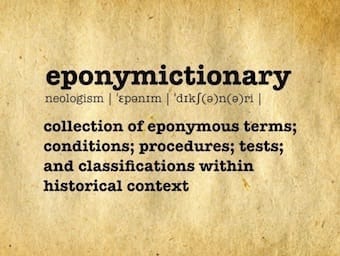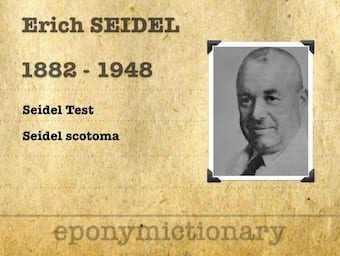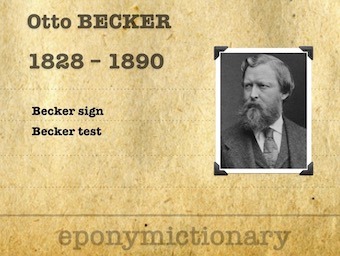Petrus Waardenburg
Petrus Johannes Waardenburg (1886 - 1979) was a Dutch ophthalmologist and geneticist. Waardenburg syndrome (1951); Waardenburg-Jonkers disease (1961); and Shah-Waardenburg syndrome (1981)
Petrus Johannes Waardenburg (1886 - 1979) was a Dutch ophthalmologist and geneticist. Waardenburg syndrome (1951); Waardenburg-Jonkers disease (1961); and Shah-Waardenburg syndrome (1981)
Albert Terson (1867 - 1935) was a French ophthalmologist. Terson Syndrome (1900)
Moritz Litten (1845 - 1907) was a German physician.

Vitreous, retrohyaloid, retinal, or subretinal haemorrhage occurring consequent to an acute intracranial haemorrhage or elevated intracranial pressure.

Erich Seidel (1882 – 1948) was a German ophthalmologist. The Seidel Test (1921) is used to assess the presence of anterior chamber leakage in the cornea following trauma.

Otto Heinrich Enoch Becker (1828-1890) was a German ophthalmologist, eponymous with Becker sign, and Becker test for astigmatism.

Roth spots: Retinal haemorrhages with white or pale centres, commonly associated with subacute bacterial endocarditis and immune complex mediated vasculitis.

Edwin Sterling Munson (1870-1958) was an American ophthalmologist.Munson sign, a V-shaped indentation of the lower eyelid when the gaze is directed downwards, an indication that is characteristic of advanced keratoconus.

Exophthalmos is abnormal protrusion of the eyeball or eyeballs. Differential diagnosis

A pupil that responds by constricting more to an indirect than to a direct light, seen with unilateral optic nerve or retinal disease

Robert Marcus Gunn (1850-1909) was a Scottish Ophthalmologist. Marcus Gunn pupillary phenomenon (1902), aka relative afferent pupillary defect or RAPD

Biographical Timeline Medical Eponyms Young–Helmholtz Trichromatic Theory of Colour Vision Helmholtz expanded on the earlier hypothesis of Thomas Young (1773–1829), who proposed that human colour vision relied on three types of retinal receptors. In the mid-1850s, Helmholtz refined this into…